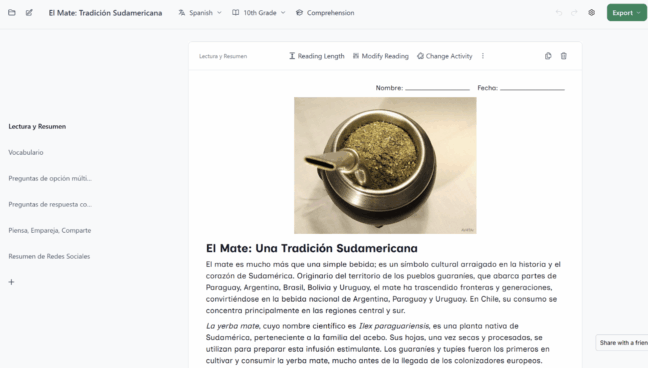by Victoria Berasaluce Guerra (LTL Contributor)
Whenever we start a technology unit or lesson in my class, AI is brought to the forefront of the conversation as an example. Students are not sure how to feel about it. They express it is helpful but will make people lazy and that it someday might take a lot of jobs off the market. Their concerns are valid. As educators, we cannot ignore the presence of AI in our contemporary world. Like teaching how to browse for online information and assess sources, how to use AI and what to be aware of is going to become one of the skills for the 21st century. We have a responsibility to help our students develop critical thinking skills regarding this area of technology.
How do I get Started?
One of the ways you can start or deepen the conversation around AI is with a movement activity, such as the Likert scale. In this activity, students will hear a question and move across an imaginary line to show their positions between “strongly agree” and “strongly disagree”, or a scale from 1 to 10.
The first questions are guided towards ethics and “how bad is AI?”. The last questions are geared towards “have you ever used AI?”. After students take positions, the teacher guides the discussion around the students’ answers. Students start smiling when some of them don’t want to give away if they have used it for homework or essays.
When using AI in your classroom, remember that it is imperative to discuss how AI works, the advantages and disadvantages. In the next section, I am going to focus on some of the ways you can implement AI to engage students and enhance your teaching experience.
Some AI tools to try out
Mizou
If you have used Chat GPT to make your students chat with a bot using their language skills, Mizou is a more accurate and personalized way to do that. It basically let’s teachers create and customize AI chatbots for 1-1 student interactions. It does require skills at writing specific prompts that will guide the chatbot and not let them go into “hallucination” mode (when the bot starts getting confused or deviates from the prompt). A nice feature is that you can include your rubrics or lesson materials for the chatbot to consider when responding and even grading.
Suno
Is an amazing tool to create music based on styles, prompts and vocabulary you choose. Warning: you might get some of your musician students to feel “cringey”. However, Suno is unbelievable to refresh your lessons. I never tell my students who the artist is when I first play a song, I let them guess the artist only to reveal to them later that it is AI-generated. I can assure you I’ve seen many mouths drop with this tool. No matter the lesson or level of your students, you can customize a song based on your lesson needs and tackle new vocabulary and tenses in a new way. No more scrolling the internet or Spotify to find that perfect song that will fit your lesson, although if you do, that’s great also!
Diffit and QuestionWell
Diffit and QuestionWell platforms allow you to use existing curriculum or generate content, including assessments and different templates for student activities. Teachers can customize the results to make them specific to their grade level, the lesson and language. Some of the outcomes for Diffit for example include fiction, non-fiction, images, summaries and key vocabulary. You can even make the information customized to be based on real, cited sources.
Khanmigo and Magic School AI
Khanmigo and Magic School AI all-encompassing websites are the closest thing you will get to a teacher’s personal assistant. And we all need one, right? Explore AI-generated rubrics, lesson plans, classroom newsletters, exit tickets and even teacher jokes! One of the great assets of these platforms is that it saves teachers’ valuable time. Think about always reviewing and editing the materials before use.
AI enlightenment
The AI universe will continue evolving and expanding. If we want to foster AI literacy in our classes, we need to become AI enlightened educators and help our students analyze the implications of using AI. Teachers should prepare to acquire the necessary skills to grow their practice and knowledge around AI to engage students by teaching them about and with twenty-first-century instruments.
To be continued…
Follow our upcoming LTL in the next months for actionable strategies on how to apply these AI tools. I will demonstrate with specific examples and considerations, how to integrate these resources into your curriculum to transform your practice. You will never look back!

